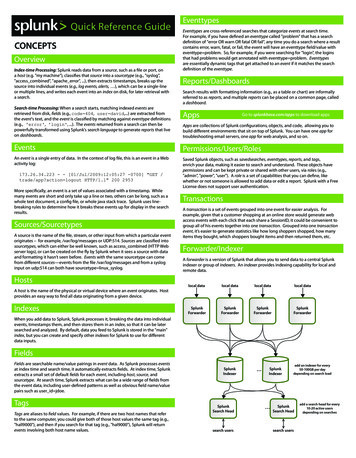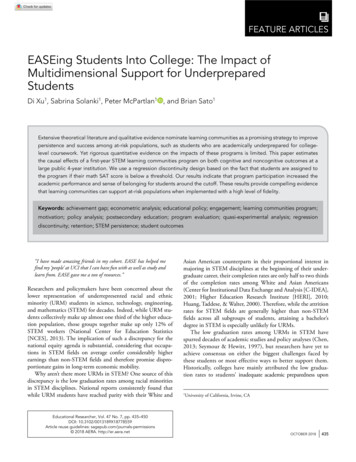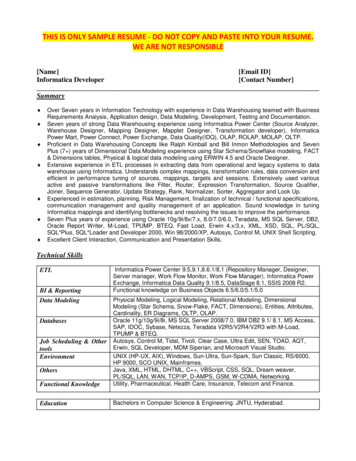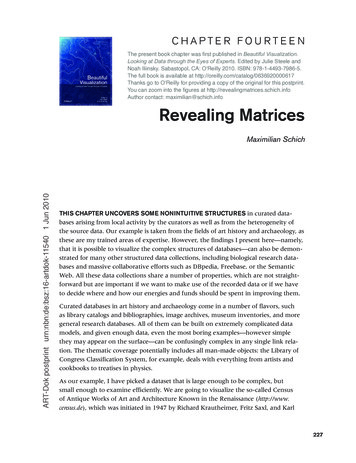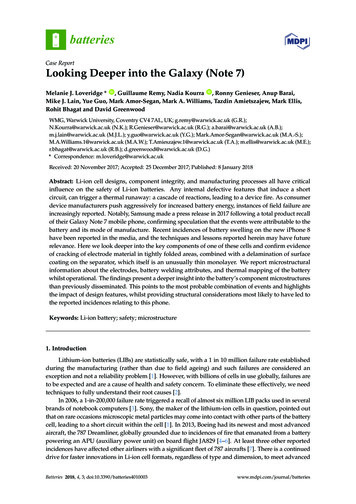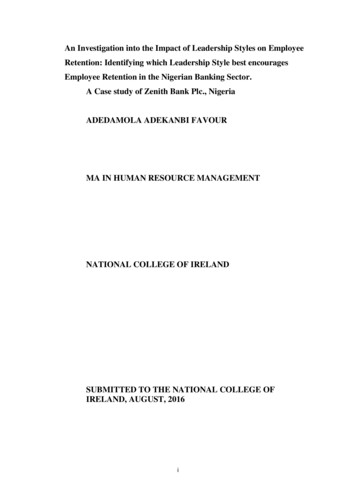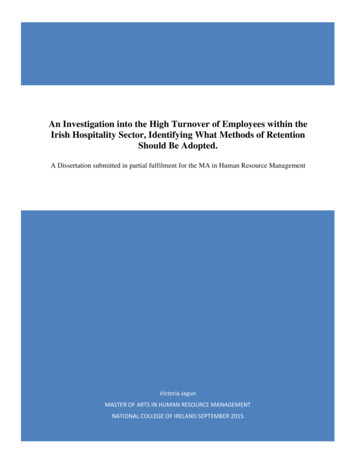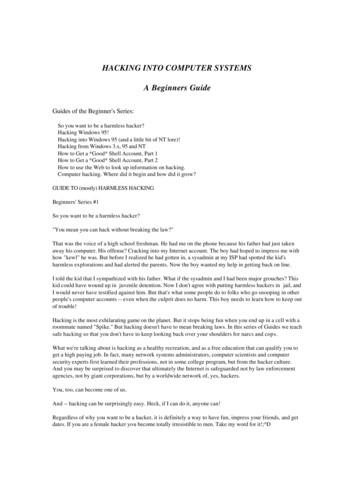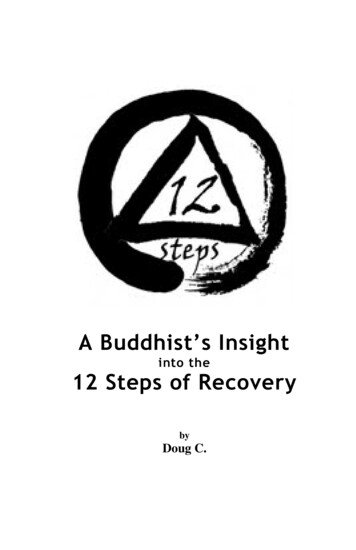
Transcription
A Buddhist’s Insightinto the12 Steps of RecoverybyDoug C.
A Buddhist’s Insight into the 12 Steps of RecoveryA Short Introductory NoteOur successful recovery in any 12-Step program deeply depends on ourmaking a spiritual practice an intimate part of our daily lives. No matterif it is NA, OA, Al Anon, AA, or any other program molded from theprinciples developed by Bill Wilson, and as early as Steps 2 and 3, itbecomes clear that spirituality is a critical component in our continuedrecovery from the disease of addiction.Many people in recovery discover and investigate Buddhism as aspiritual path because the 11th Step advises us to meditate, and thevarious Buddhist traditions, over the last 2,500 years, have developedmany comprehensive and sophisticated systems of meditation. Anotherreason Buddhism appeals to a broad range of people in recovery isbecause it is an experiential spiritual practice that empowers us toimprove our conscious contact with a Greater Power of ourunderstanding through rational investigation, contemplation, andprofound insight, rather than a religion that requires blind faith of itsfollowers.From the very beginning of his ministry, the Buddha invited his disciplesto investigate his teachings and prove their legitimacy for themselvesbefore accepting them. In fact, the Kalama Sutra recalls theBuddha’s words on accepting religious teachings on blind faith this way:“There is no use going by tradition or lineage, by what others say or whatothers have written or the teacher’s authority. When you know foryourself that these ways are wholesome, that these ways arepraiseworthy, that these are the ways approved by the wise, that theseways, followed and practiced, will certainly lead to well-being and1
happiness, then these ways must be the ways to follow.” Buddhism’ssound empirical approach to spirituality may be the reason that AlbertEinstein said, “Buddhism has the characteristics of what would beexpected in a cosmic religion for the future: It transcends a personal God,avoids dogmas and theology; it covers both the natural and the spiritual,and it is based on a religious sense aspiring from the experience of allthings, natural and spiritual, as a meaningful unity.”Both the 12 Steps and Buddhism are practices that deal with addictionand craving as the cause of our suffering and prescribe proven methodsof recovery. 12 Step Buddhism is a complementary practice for therecovering addict that combines basic Buddhist practices with traditional12 Step techniques and offers us a powerful path to freedom that plungesbelow the surface of addiction and addresses its causes. It isn’t areplacement for a traditional 12-Step program, but a supplementalpractice proposed to help us experience our recovery on a deeper level byapplying Buddhist techniques and insights; some, like the Five MoralPrecepts and the Eightfold Path, are specific to Buddhism and not atraditional part of formal 12-Step programs. For that reason, wemaintain, and encourage newcomers to establish, a working relationshipwith a home recovery group. Furthermore, we diligently work our homegroup’s program while enriching and strengthening our recovery withour Buddhist practice. Because of the countless forms that the disease ofaddiction takes, all manifesting if untreated in an endless cycle ofsuffering, 12-Step Buddhism doesn’t just concentrate on any one form ofaddiction, but addresses all forms of unmanageable craving.
This booklet is a contemplation of the 12 Steps of Recovery from aBuddhist’s perspective. It is inspired and based on works written byDarren Littlejohn, Kevin Griffin, Noah Levine, Laura S. and othergroundbreaking pioneers in the Buddhist recovery movement. Some ofthe language of the traditional 12 Steps has been revised in order tocorrespond more consistently with a Buddhist understanding of 12-Stepconcepts, like higher power, turning over, and surrendering our will.Each of the 12 Steps has a short description of Buddhist beliefs,doctrines, and practices corresponding to the basic principle underlyingthe individual step. This booklet is intended to be nonsectarian and drawsupon the wisdom and practices of several Buddhist schools andtraditions. However, as you might expect, my insight has been broadlyinfluenced by the beliefs and practices of the Buddhist denomination towhich I belong, Shin Buddhism, which is a Japanese Pure Land schoolfrom the Mahayana branch of Buddhism.Palms Together in Love and Respect,Doug C.
A Buddhist’s Insight into the 12-Steps of Recovery STEP ONE We admitted that we were powerless over our craving and addictionand that our lives have become unmanageable.The Buddha taught in the First and Second Noble Truth that life ispermeated with suffering and that ignorance, delusion, and craving arethe cause of our suffering. In other words, that our addictions not only tovarious substances and behaviors, but also to unwholesome andunskillful beliefs, attitudes and thoughts, have trapped us in a viciouscycle of suffering that is beyond our control. According to the Buddha’steachings, this cycle begins with ignorance and delusion, which initiatesa chain reaction, called nidanas in Sanskrit that leads to our craving thatin turn leads to our suffering. One example of ignorance and delusion iswhen we are in denial about our addiction while it is making our livesunmanageable and causing us unbearable suffering. This unbearablesuffering leads us to engage in our addiction again and again as this cycleof suffering continues.
STEP TWO. We came to believe that a Power greater than our individual selvescould restore us to wholeness.The Buddha taught in the Third Noble Truth that there is a way totranscend our cycle of craving and suffering. The Buddha’s teachingsfrom beginning to end were all centered on how to cope with and movebeyond our cycle of craving and addiction, and its inevitableconsequences, which are the grief, distress, and agony that we cause inour own lives as well as in the lives of the people that we touch. TheBuddha’s teachings will, over time, lead us to a deep personal insightinto our interconnectedness with a Power that is greater than ourselvesand yet is not separate from ourselves, and what that relationship meansto our recovery. STEP THREEWe made a decision to take refuge in and entrust ourselves to thecompassion and guidance of a Greater Power of our understanding.As part of our Buddhist practice for surviving and moving beyond ourcraving and suffering we “take refuge” in the Buddha, the Dharma andthe Sangha, also called the Three Jewels. “The Buddha” not only refersto the historical Buddha, but also the Oneness of the Universe, the TrueNature of all beings (including ourselves) and to all the boundlessmanifestations of Buddhahood, including our teachers, sponsors andmentors. “The Dharma” is the teachings of Buddhism, the path torecovery, Universal Law and Reality-as-it-is. “The Sangha” refers to ourBuddhist community, both local and worldwide, and our recoveryfellowship. Buddhists around the world devote profound prasada, aSanskrit word that means lucid-serene-trust, to all the countless facets ofthe Buddha, Dharma and Sangha as a Greater Power. Taking Refugemeans that we turn to the Three Jewels not only as a shelter from ourcraving and the suffering that it causes, but also as a light to guide usthrough the darkness of our ignorance and delusion.
STEP FOURWe made a searching and fearless moral inventory of our thoughts,words, and deeds.The Buddha taught that our thoughts, words, and actions have an effecton our own lives as well as the lives of others and on the entire world.We call this basic principle karma, a Sanskrit word that means “action.”The Law of Karma establishes that we do indeed participate in thecreation of our own lives. Therefore, our recovery is deeply dependenton acknowledging that our actions do actually matter and sincerelytaking ownership of the consequences of our actions. As long as wecontinue to cast ourselves in the role of victim and absolve ourselves ofany responsibility for our own circumstances and experiences, wecontinue to lack the motivation to transform our attitudes, behaviors, and,ultimately, our lives. By directly and openly bearing witness to the natureof the suffering and pain that we inflict on ourselves and others, we arepropelled into action that will transform our lives and the world. STEP FIVEWe admitted to ourselves, our Greater Power, and another humanbeing the precise moral nature of our thoughts, words, and deeds.The Buddha during his lifetime initiated a ceremony called upavasatha,which is a Sanskrit word that means “cleansing of the defiled mind.” Inthis ceremony, disciples of the Buddha admitted to their fellow Sanghamembers the nature of their unskillful and unwholesome thoughts,words, and deeds in order to deepen their spiritual practice andexperience greater inner tranquility. When we share with another humanbeing the exact nature of our internalized guilt and shame we take a vitalstep along the path of recovery and true spiritual healing. The act oftelling someone our darkest secrets allows us to step back from ourstories and their related feelings, beliefs, and behaviors, and bring theminto the light of integrity. We can then look at them objectively so thatwe can see deeply and more clearly the suffering that we have causedourselves and others. Sharing with another person also gives us neededfeedback so that we can see from the perspective of an objective,nonjudgmental observer where we are distorting our stories, either todiminish our responsibility or to assume an unrealistic and overwhelmingburden of blame. Upavasatha, or “admitting the precise nature of ourunwholesome and unskillful behavior,” is not only critical to our
recovery, but it also heals us spiritually as well as helps to mend ourfractured relationships. STEP SIXWe became entirely ready to have our Greater Power transform ourunwholesome characteristics into wholesome ones.The Buddha taught the principle of naiṣkramya, a Sanskrit word thatmeans “renunciation and freedom from craving and clinging,” as one ofthe paramitas or virtues that lead to spiritual awakening. In preparing fortransformation, we must become willing to let go of our unwholesomequalities and allow our Greater Power (of our understanding) totransform them into wholesome ones. By taking refuge in our GreaterPower, then letting go of and turning over the unwholesome aspects ofour personalities and their interconnected, entrenched habit energies andrelated behaviors, we are able to become one with our recovery processin a way that is greater than our own ability to control or to predict thefinal outcome. The Buddhist doctrine of naiskramya means not onlyrenouncing our unwholesome characteristics, but also letting go ofcontrol over the process and not trying to manipulate the outcome. It isonly when we let go of trying to manage a future, which is unknowableand in reality is subject to countless factors that are beyond our control,that we can truly live in the present moment. The present moment iswhere our lives are actually taking place, and it is always in the presentmoment that all transformation and liberation occur. STEP SEVENWe humbly turned our unwholesome and unskillful qualities over toour Greater Power to be transformed into positive ones.The Buddhist doctrines of anatta and sunyata teach us that everythingwe encounter, including ourselves, has no absolute permanent identity orcharacteristic. These two teachings reveal the truth that not only ischange possible, but in reality change is inevitable and unavoidable.Anatta is a Sanskrit word that literally means “Not-Self,” or that there isnothing about us that is not subject to change, nothing about us that ispermanent, nothing about us that is not dependent upon environmentalcauses and conditions. Sunyata is a Sanskrit word that means“emptiness”—in other words, that all things in existence are
impermanent, with no perpetual state of being, and are in a constant stateof flux, undergoing continuous transformation. It is important tounderstand that anatta and sunyata are not denials of our existence or theexistence of the material world, but rather that everything about us andour characteristics—spiritual, mental, and physical; wholesome andunwholesome—and even our situations and environments, are constantlyundergoing transformation, which is determined by our karma, which isitself also subject to emptiness and impermanence, and as a result ischangeable. This means that we are not trapped by our habit energy andthat we can truly experience a complete transformation of ourunwholesome and unskillful qualities, into positive, wholesome ones.Another aspect of anatta is humility, a deep understanding that we arenot special—not higher and not lower not greater and not lesser—butrather share the same universal nature with all sentient beings. This is ourBuddha nature; this is who and what we really are, and it is through thisuniversal goodness and universal compassion that we can be restored tosanity. As part of the upavasatha, or “cleansing the defiled mind,” manyBuddhists say an Atonement Prayer, similar to the one below, as a wayof asking for their unwholesome and unskillful characteristics to betransformed into positive ones.All evil karma ever committed by me since before time,Because of my vast greed, anger, and ignorance,Born of my body, mouth, and mind,I now atone for it all.May it be transformed for the good of all beings. STEP EIGHTWe made a list of all persons we had harmed, and became willing tomake amends to them all.According to Buddhist teachings on Karmic Law, our intentions give riseto our karma or actions; from our actions karmic seeds arise, which thenripen into karmic results or vipaka, a Sanskrit word meaning “ripenedfruit.” Desirable vipaka is the result of skillful and wholesome actions,and undesirable vipaka is the result of unskillful and unwholesomeactions. Moreover, our karma is both continually ripening andcontinually being generated by our current actions. This means that it isentirely possible to reshape our future karma and its ripening fruitthrough the choices and actions that we embrace and carry out today.
Cetana, a Sanskrit word meaning “intention,” is not only the energysource from which our karma is generated, it is also the energy sourcefrom which our karma can be neutralized. This is because our intentionsare the primary mover of all of our other mental actions, like feelings andthought, and determine the direction of our mind, which then determinesour behavior and actions, or our karma. Buddhism teaches that we canpurify negative karmic seeds through the Four Purifying Powers, whichare: the Power of Regret, the Power of Promise not to repeat the action,the Power of Repair or making amends, and the Power of RemedialActions or service to others. But all these powers rely on our cetana.When we make a list of all persons we have harmed and become willingto make amends, we activate the Power of Regret, as well as the Powerof Promise not to repeat the action, and we set our intention, which is thesource energy of all positive and negative karma. As we touch thesadness, as the tears arise and as we face the devastation we’ve caused inthe lives of our loved ones and the other people on our list, it is thePower of Regret that gives rise to the Power of Promise not to repeat our(unwholesome and unskillful) actions, and our intention to engage thePower to Repair or make amends. STEP NINEWe made direct amends to such people wherever possible, except whento do so would injure them or others.The final two Purifying Powers of Buddhism, the Power of Repair andthe Power of Remedial Actions, are directly related to and are put intoaction by making amends. The Powers of Repair and Remedial Actioncontain the power to heal and to transform our past karma and its results.First we transform ourselves from being a person who avoids acceptingresponsibility for our actions into a person who takes responsibility forour actions. Next when we confront the reality that we are imperfect justlike everyone else, and that we too make mistakes just like everybodyelse, the negative emotions that gave rise to our harmful actions areneutralized and transformed into positive emotions that give rise tobeneficial actions. In Buddhism we believe that negative emotions areunwholesome states that interfere with our spiritual development. So bytransforming our negative emotions, through the humility it takes to trulyown and admit to our mistakes, the roadblocks that obstruct our recoveryare transformed into what are referred to in Buddhism as the FourHeavenly States: of Loving-kindness, Compassion, Sympathetic Joy, and
Equanimity. Another transformative power of making amends is thepower of forgiveness. Yes, forgiveness from others feels good, but just asimportant is that we forgive ourselves. We have to offer and accept selfforgiveness; while we all have harmed others through our unskillful andunwholesome acts, or negative karma, the not-so-obvious victim of our“wrongdoing” is us. Every harmful action we engage in leaves us copingwith the emotional weight of being a “bad person.” As we engage thePower of Repair and the Power of Remedial Actions on the physicallevel by apologizing to the people that we harmed, making restitutionthat is appropriate to our resources, performing community-service workas well as individual selfless actions that benefit other beings, we canalso invite spiritual healing and transformation through metta, or“Loving-kindness” meditation. This is a traditional meditation that wastaught by the Buddha himself to his disciples. In metta meditation, wehold a person in our mind and recite phrases like:“May you be safe, may you be well, may you be happy, and may you livein peace.”We can use the above phrases or other words with similar meaning thatfeel more natural to us. In traditional Metta meditation we begin withsomeone who is “easy” to feel kindness toward. Then we expand ourmeditation to include others in our life, even people who we may have adifficult relationship with. And, ultimately, we include all beings in theworld. This meditation helps us to heal relationships in our own mind,even when the person doesn’t want to talk to us, when we can’t makedirect amends, when we can’t find the person for some reason, or evenwhen that person has died. STEP TENWe continued to remain mindful of our mental, verbal, and physicalactions, and when we acted unskillfully, promptly admitted it.Buddhist teachings advise us that it is more beneficial to avoid thecreation of karmic seeds than to worry about ripening karmic fruit. It isthe karmic seeds that we create through our mental, verbal, and physicalactions that trap us in our cycle of addiction, craving, and suffering. Thismeans that we need to be continuously mindful of our thoughts, words,and actions, and be ready to apply the Four Purifying Powers themoment we become aware that we somehow slipped up or harmed
someone. This will prevent our becoming caught in a cycle ofattachment, resentment, and denial, as well as prevent the accumulationof negative karmic seeds. Buddhist ethics are primarily based on theunderstanding that we’re interconnected to all life and that anything wedo to any other living being we ultimately do to ourselves. However, thisconcept is rather abstract, and using it as a guide to determine when weneed to make amends may be a little tricky. So, one useful andundoubtedly more straightforward ethical compass that can help us findsome clarity on our actions and their karmic implications is the FiveMoral Precepts. These precepts were taught by the Buddha as a guide forhis lay disciples and have been handed down over the last 2,500 years,benefiting each generation until they were inherited by us in our time.The application of the precepts is simple: if our actions are somehowoutside the principles and parameters of these precepts, then we probablyneed to make amends. While the precepts are more guidelines thancommandments (and strictly speaking not part of a traditional recoveryprogram), ideally, we would want to try to live in harmony with them notonly as a way to live a more happy and wholesome life, but also aswonderful guidelines to help us maintain our sobriety. Each of the FiveMoral Precepts is listed below with an affirmative aspect that is thefoundational spirit that the precept is based on, which in turn generatespositive karma, and a type of behavior to avoid because it generatesnegative karma.I embrace the teaching of loving-kindness; I abstain from harmingothers. This precept counsels us to avoid intentionally hurting or killingany living being. But it also means that we should not be the cause of—or approve of—harm coming to any living being. This precept is not onlyappealing to us to avoid doing harm to their physical bodies, but likewiseto refrain from inflicting mental, emotional, and spiritual injury as well.Moreover, it means that we should try to treat all beings with kindnessand compassion.I embrace the teaching of generosity; I abstain from taking things notfreely given. precept counsels us not only to abstain from cheating andstealing, but it actually advises us to avoid participating in, throughcommission and omission, all forms of exploitation, injustice, andoppression, and to cultivate generosity and loving-kindness toward allliving beings.
I embrace the teaching of respect for all beings; I abstain from sensualmisconduct. This precept counsels us to abstain from sexual abuse orother sexual activities that cause harm to ourselves and others, to abstainfrom sexual relations without love and a long-term commitment, as wellas to honor our commitments and the commitments of others. But thereis an additional bit of guidance as well: to avoid immoderate indulgencein any physical or sense pleasure such as overeating, overindulgence inentertainment like video games or television, or other compulsiveescapist behaviors.I embrace the teaching of mindful communication; I abstain fromdeception and discord. This precept counsels us to avoid false andinsincere speech, as well as speech that is harsh, harmful, and slanderous.It also advises us to cultivate speech that is loving, beneficial, andintended to bring happiness to others. Another aspect of mindfulcommunication is deep listening; often the most compassionate discoursewe can offer to others is to simply be present for another person and trulywitness his or her life experiences, both joyful and sorrowful.I embrace the teaching of mindfulness; I abstain from substances andactions that lead to intoxication and heedlessness. This precept counselsus to cultivate mindful consumption and sobriety and to abstain not onlyfrom drugs, alcohol, and other intoxicating substances, but also to avoidanything that has toxic effects, such as pornography; certain films,television programs, books, magazines, foods, and activities (likegambling or enabling another person’s addiction); or even someconversations. Keeping this precept benefits our own mental, spiritual,and physical health, and promotes our families’ and communities’ wellbeing, too. Embracing and keeping the Fifth Precept not only helps us toavoid indulgence in substances that could cause us to disregard the firstfour precepts, but also for those of us in recovery, it is a vital tool forpreventing our relapse or even developing new addictions that wouldseize control of our lives and return us to our former wretched existence.
STEP ELEVENWe engaged in meditation and prayer in order to improve ourconscious contact with our Greater Power (of our understanding) andto gain the insight and strength to realize and attain our GreaterPower’s compassionate aspiration for us.Most people who turn to Buddhism after entering recovery investigate itbecause of the wide-ranging and highly developed meditation practicesfound in many Buddhist traditions. All forms of Buddhist meditation,whether they be contemplation, visualization, sitting, standing, orwalking, fit between and encompass the two poles of meditative practice;in Sanskrit these are called samatha, or “calm abiding” (sometimescalled single-pointed concentration), and vipassana, or “clear seeing”(also known as insight meditation). Single-pointed concentration is ameditative practice where we truly not only “accept the things we cannotchange,” but we also develop the courage to change the things that wecan. To practice this meditation, we calm our busy minds: we sit with ourbreath (or some other object of concentration) and just allow our mentalactivity to naturally wane, returning again and again to our breathwhenever our mind inevitably wanders. In this way we not only developserenity and tranquility, we change the only thing that we truly canchange, our mind. Insight meditation is a distinctively Buddhist practicethat helps us to develop insight into the nature of “things,” includingourselves, through our focused attention. As we sit in awareness of ourbreath, body, mind, and environment, this form of meditation encouragesour cultivation of “the wisdom to know the difference” between thethings we can change and the things we can’t. Regardless of what formof meditation we choose, research has demonstrated that meditation hasnumerous medical and psychological benefits: it reduces stress hormonesand boosts our immune system, alleviates past psychological traumas,and enhances our overall sense of well-being. Meditation is a powerfulfriend to anyone who employs it in support of their recovery.Buddhists recognize prayer as a powerful method of meditation. Prayeris a mindfulness practice where our awareness and concentration are notonly cultivated, they are also combined with our lucid-serene-trust andset into harmony with our aspirations and intentions. This union thenunleashes our potential to awaken to our intrinsic Buddha nature andtransform our confusion into clarity and our suffering into joy. In otherwords, prayer focuses our aspirations and transmits them to the Oneness
of the Universe, which also includes us; from this boundlessness, thewellspring of all possibilities, and the laws of cause and effect, beneficialresults arise. Our meditation practices can be either passive or active;prayer is a dynamically active form of meditation. When many Buddhistsoffer prayers it is often for the benefit of other beings; this opens ourlives up to boundless compassion, which is greater than and embracesour individual cravings, delusions and suffering. This prayer written byDarren Littlejohn, author of The 12-Step Buddhist, is an excellentexample:“We dedicate the merits of this practice to all suffering addicts. Mayeveryone be free of suffering, and the causes of suffering. May everyoneenjoy happiness, and the causes of happiness.”In Buddhism, we believe that we can improve our conscious contact withour Greater Power (of our understanding) through prayer and meditation.However, we also deepen our connection by leading a life that is inharmony with the Eightfold Path, which was prescribed by the Buddha,who is sometimes called the peerless physician, because the fourth of theFour Noble Truths is the best medicine for transforming our craving,addiction, and suffering into happiness. The Eightfold Path concentrateson three essential areas of Buddhist spiritual practice: Prajna or“wisdom”; Sila, or “ethical actions” such as the Five Precepts; andSamadhi, or “mental training,” such as meditation and mindfulness. Inthe Eightfold Path, the Sanskrit word samma means “accurate,wholesome, complete, and skillful.” While renditions of the EightfoldPath often use the English word right when translating samma, thiswould be less than accurate, because the opposite of Samma is not theword wrong, but rather incomplete, unwholesome, and unskillful. Belowis a list of the aspects of the path in Sanskrit with English explanation.The Noble Eight Fold Path:Samma-Ditthi: Complete and wholesome understanding of the nature ofreality and the path to recovery and transformation.Samma-Sankappa: Proper and wholesome aspiration; intention that ismotivated by love, compassion, and a desire to transform our lives.Samma-Vaca: Skillful and wholesome speech; truthful, beneficial, andnonharmful communication.
Samma-Kammanta: Skillful and wholesome action; a life based on theprinciple of non-exploitation of oneself and others; living in harmonywith the Five Precepts.Samma-Ajiva: Wholesome and proper livelihood; a livelihood that isbased on the ethical principal of non-exploitation, that is beneficial toothers and self, and that is in harmony with the Five Precepts.Samma-Vayama: Wholesome and complete effort; consciously directingour efforts toward actions that benefit others and ourselves, andtransforming our lives and our world into a pure land full of lovingkindness and compassion.Samma-Sati: Complete and skillful mindfulness; developing completeawareness of oneself, feelings, thoughts, people, surroundings, andreality.Samma-Samadhi: Holistic and wholesome meditation; types ofmeditation that enhance and develop wholesome mindfulness andunderstanding. STEP TWELVEHaving realized a spiritual awakening as a result of these steps, wecarry this message to others in need of recovery, and try to practicethese principles in all our affairs.In Mahayana Buddhism, a Bodhisattva is a being who has taken a vow towork for the liberation of all sentient beings before entering into Nirvanahim- or herself and escaping the cycle of birth, death, and suffering. The12th Step coincides with the Buddhist Bodhisattva Vow: “I vow toliberate numberless sentient beings. I vow to transform endlessafflictions/delusions. I vow to master innumerable practices anddoctrines. I vow to embody the unsurpassed Buddha Way.” Zen MasterKobo Daishi (7
A Buddhist’s Insight into the 12 Steps of Recovery A Short Introductory Note Our successful recovery in any 12-Step program deeply depends on our making a spiritual practice an intimate part of our daily lives. No m
